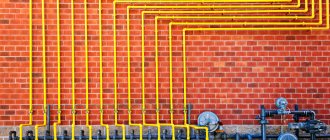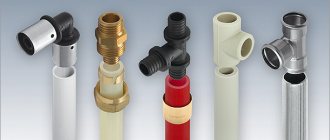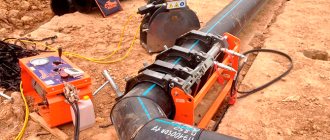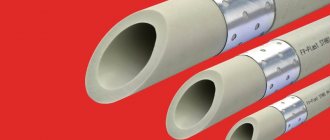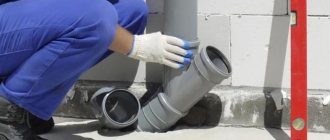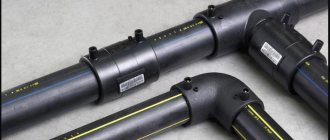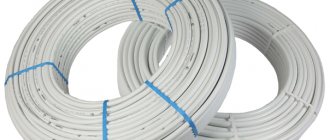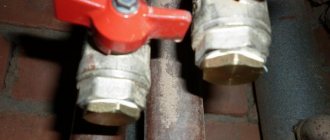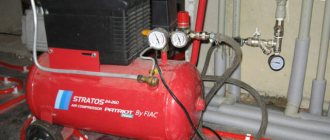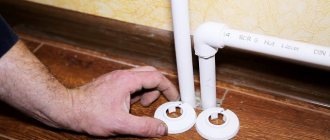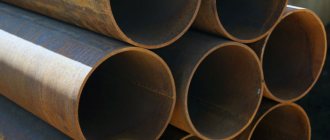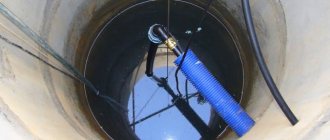PEX-a cross-linked polyethylene piping system PIPEX
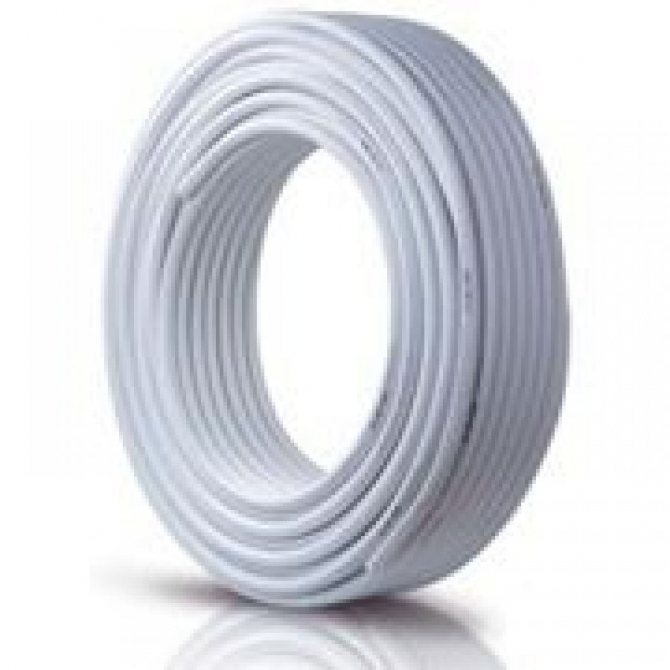
XLPE piping system
PEX-a PIPEX (Spain)
Benefits of pipes PIPEX:
- The PEX piping system is easy to install, does not require welding, and does not require electricity.
- Flexibility. PEX-A pipes are more flexible than PEX pipes with other cross-linking methods. They can be bent even in a cold room.
- Resistant to high temperatures. They can be used at temperatures up to 95ºC and even 110ºC for some time (according to the technical parameters of the system).
- Resistant to high pressures, which affects the durability of the system - service life is more than 50 years.
- Resistant to corrosion. Suitable for transporting even corrosive liquids.
- Minimal friction losses. The roughness of the walls of PIPEX pipes, and therefore the roughness factor, is significantly lower than that of metal pipes. This reduces the energy requirements for pumping water and allows you to pump a larger volume of water, with equal internal diameters of the pipes.
- Calcium deposits are not formed. The pipe is prevented from overgrowing and the pressure loss is kept low over the entire service life of the system.
- Resistant to abrasion.
- Light weight. The pipe weighs 7 times less than a copper pipe and 13 times less than an iron pipe of equivalent diameter.
- Optimum sanitary and hygienic characteristics. They do not change the organoleptic properties of drinking water.
- Insulating. Low coefficient of thermal conductivity, provides energy savings while reducing heat loss.
- Frost resistant. The destruction of the pipe does not occur with several cycles of freezing of water in them.
- Does not conduct electricity - a guarantee of protection against galvanic corrosion.
- Do not transmit noise. Due to the elasticity of the pipe, the transmission of sound waves is significantly reduced, even at high circulation rates of water, compared to metal pipes.
- Suitable for seismically hazardous areas. Due to their resilience and elasticity, they can absorb higher stresses than metal pipes.
- Molecular memory. In case of breaks, the PIPEX pipe easily restores its shape, without loss of properties, by heating with a technical hairdryer.
- The term of operation, subject to technical conditions, is at least 50 years, the warranty period is 10 years.
Precautions:
- it is necessary to store the pipe indoors in a package, avoiding direct sunlight,
- avoid contact of the pipe with hard and sharp objects, due to which it can be damaged
- the minimum bending radius should be 5 times the nominal diameter of the pipe, if the installation is carried out in a cold room, the radius may be smaller if a technical hair dryer is used,
- do not expose the pipe to direct flame,
- use plastic fasteners for fastening the pipeline, metal fasteners can damage the pipeline during installation and operation,
- do not use chemical solvents or similar substances during the installation of the pipeline,
-after the installation of the pipe is completed, it is necessary to carry out a load test to identify possible leaks, pressure testing is carried out according to the operating conditions.
Scope of pipelines PIPEX
- for the device of hot water supply and cold water supply systems,
- heating by radiators, according to SNiP 41-01-2003, SP 60.13330.2012
- water floor heating devices,
-systems of snow melting at the entrances of buildings,
- for air conditioning systems,
-for industrial production (transportation of compressed air, pumping of caustic and toxic substances),
- objects of animal husbandry.
Quality control
All products undergo a triple quality control:
- control of geometric parameters (inner and outer diameters, wall thickness along the entire length of the pipe),
- in the laboratory of the factory, the physical and chemical parameters of each batch of products are monitored.
Pipe products comply with all European requirements UNE-EN 579, ISO2505, UNE-EN728, ISO6964, ISO6259 and Russian GOST 52134-2003.
TECHNICAL CHARACTERISTICS OF PEX-a PIPES PIPEX
| Characteristics | Value | Unit of measure |
| Density | 951 | Kg / m3 |
| Crosslinking degree | >75 | % |
| Roughness | 0,007 | Mm |
| Maximum working temperature | 95 | Gr. C |
| Maximum operating time at 120g. C | <2.5 | h |
| Linear expansion coefficient | 1,5*10-4 | K-l |
| Thermal conductivity | 0,35-0,38 | W / m * K |
| Melting temperature | 130-132 | Gr. C |
| Tensile strength | >22 | N / mm2 |
| Elongation at break | >400 | % |
| Elastic modulus at 20g. C | >800 | N / mm2 |
| Internal pressure resistance p=4.8Mpa 95grS | >1 | h |
| Internal pressure resistance p = 4.7Mpa 95grС | >22 | h |
| Internal pressure resistance p = 4.6Mpa 95grС | >165 | h |
| Internal pressure resistance p = 4.4Mpa 95grС | >1000 | h |
| Internal pressure resistance p = 2.5Mpa 110grС | >1 | year |
Cross-linked polyethylene pipe Rekh-a series 3.2 (10bar)
with oxygen barrier EVOH for heating system (gray color)
| O.D. mm | Wall thickness mm |
| 16 | 2,2 |
| 20 | 2,8 |
| 25 | 3,5 |
| 32 | 4,4 |
Rekh-a cross-linked polyethylene pipe for underfloor heating (8bar)
with oxygen barrier EVOH (color red)
| Outside diameter mm | Wall thickness mm |
| 16 | 2,0 |
| 20 | 2,0 |
RECOMMENDATIONS FOR THE APPLICATION OF THE PIPE PIPEX PEX-a
FROM MOLECULAR-CROSS-LINKED POLYETHYLENE.
1. During transportation, pipes must be kept in their original packaging at all times and placed on smooth and flat surfaces. It is recommended to transport pipes in closed vehicles and store them indoors. Preparation of a horizontal surface for pipe-laying: it must be checked that the surface is level and free of foreign objects. Unpacked pipes should not be exposed to direct sunlight.
2. Under the pipe layer, it is imperative to lay heat-insulating material, the thickness and type of which are calculated based on the temperature under the floor. After the completion of the installation work, a cement-sand screed is laid on top of the pipe layer (or the floor is poured) with a thickness of at least 45 mm, which implies the total height of all laying layers, including the thermal insulation plate, 16x2 pipe and the screed, at least 11 cm. different characteristics of thermal insulation materials, construction and layer thicknesses for different types of screeds and floor coverings, for different temperature conditions under the floor, etc., the thermal calculation and selection of which is carried out at the design stage.
3. There are two main types of pipe laying: spiral ("snail") and meander ("coil"), with a laying step of 5, 10, 15, 20, 25 and 30 cm (a combination of both types in one laying area is also possible). Depending on the configuration of the room, when designing, the pipe laying is divided into several sections, in each of which the pipe is laid according to the selected type and with a selected step, in order to optimize labor costs, improve the uniformity of floor heating and achieve a given surface temperature. The length of each loop should also be optimized, making sure that the length of each loop does not exceed 120 m to ensure that the entire system is hydraulically balanced. Joints along the length of the loop should be avoided. The pipe is laid from the "supply" of the collector, in the direction opposite to the winding; when unwinding, the pipe does not need to be heated. It is necessary to ensure a consistent level of laying and carefully avoid kinks, taking into account the minimum bend radius.
4. The minimum allowable bend radius without heating is five outer diameters.When heating the corresponding section of the pipe with hot air (hairdryer), the minimum bending radius can be reduced (for example, if for a pipe with an outer diameter of 16 mm, the minimum permissible bending radius in a cold state is 80 mm, then in a heated state it is 36 mm). It is necessary to monitor the uniform heating of the entire bent area. The use of an open flame to heat the pipe is not permitted! When heated, the pipe becomes translucent and much more flexible. The shape acquired by the pipe in a heated state is fixed after cooling. In the event of kinks or any bending errors, they can be eliminated by heating the pipe with hot air. The use of temperatures up to 130 ° C is recommended. At temperatures above 140 ° C, the pipe material softens and melts.
5. To eliminate heat transfer and protect the pipe in some sections, the pipe is laid in a corrugated polyethylene casing. Laying a pipe for underfloor heating (without a casing) requires special attention to the absence of heavy and sharp objects (broken bricks, etc.) that can cause mechanical damage to the pipe. The thermal expansion of the pipe in the longitudinal direction does not play any significant role with the length of the underfloor heating loop up to 200 meters. Thermal expansion in the radial direction is compensated by a layer of concrete screed of the heated floor covering the pipe, equal to at least 1.5 pipe diameters, which also solves the problem of fogging (condensation).
6. When installing underfloor heating, special attention should be paid to the horizontal laying of the pipe, which will ensure the same distance from the pipe to the floor surface after pouring. The area of the heated floor is divided (in accordance with the optimal length of one loop up to 120 m) into separate (usually rectangular, with an area of no more than 40 m, sides no more than 8 m), separated by special plastic inserts (joints), which compensates for deformations arising from thermal expansion of concrete or cement-sand screed. One such section should correspond to the laying area of one or two adjacent loops. The underfloor heating pipe can be fastened in various ways: with the help of a metal mesh on which the pipe is attached, with the help of special "harpoons" with which the pipe is attached to polystyrene plates covered with foil with markings, with clips or dowels of various types, and also with mats with clamps ”, which simplify and speed up the installation process as much as possible. Fastening of pipes is carried out at intervals of not more than one meter along the length of the pipe.
7. The point of installation of the manifold should be as similar as possible to each loop. It is desirable to install the manifold closer to the center of the system. The most optimal use of collectors from 6 to 10 points. The presence of an air valve on the manifold ensures that air is removed from the system, and the shut-off and drain valves on the manifold provide the possibility of autonomous emptying of the system section on this manifold. Temperature control of the floor surface is carried out by a thermostatic valve of the corresponding loop on the collector "return", manually or by means of a servo-drive installed on this valve, controlled by a room thermostat, which is mounted on the wall of the corresponding room. The choice of the method of temperature control - manual or automatic - is individual for each loop and depends on the wishes of the customer.
8. Hydraulic balancing is carried out by adjusting the flow rate in each loop by means of hydraulic valves on the "supply" of the collector (combined with flow meters), the number of revolutions of each of which is calculated in advance. The fitting of the fittings does not require special tools, but must be carried out by qualified and experienced personnel.Before pressing the system, it is necessary to visually check the quality of the installation and flush the system with water at room temperature to remove debris and air. The smooth inner surface of the pipe provides a high flow rate, provided that the parameters of the circulation pump and the hydraulic resistance of all elements of the system are correctly calculated. The flow rate is primarily determined by the temperature of the coolant and the maximum required heat transfer. The pressure drop across pipe bends is negligible and can be ignored. During the initial flushing of the system, a flow rate of at least 0.45 m / s is required to completely remove air from the pipe. After completing the installation and flushing the system, pressure testing should be carried out at a pressure of at least 1.3PN (PN - working pressure) for 24 hours, followed by a thorough check of the system tightness and possible additional tightening of the threaded connections.
9. Filling the floor or laying a cement-sand screed is carried out with a filled system under operating pressure. When pouring the floor, it is unacceptable to use lightweight concrete and concrete with insulating additives. It is recommended to add 1% additive (plasticizer) (0.125 kg / m of plasticizer at a height of concrete or cement-sand screed 62 mm), which improves the physical and mechanical properties of the screed (no clots, air bubbles, irregularities) and accelerates the hardening process after laying or pouring floor. According to the building codes in force in Russia, the time for complete hardening of the screed is at least 28 days (according to the rules adopted in Germany, you can walk on the laid floor in 4-5 days after laying or pouring, the time of complete hardening is 21 days, after which technological heating is carried out floor 3-4 days.
10. In winter time, freezing of the system should be avoided (especially before pouring the floor or laying a cement-sand screed: the volume of frozen water in the pipe increases, which can lead to a leakage or rupture of the pipe). If there is a possibility of freezing the heating system, you must first drain the water or use antifreeze. It should be borne in mind that the pipe becomes stiffer at low temperatures during installation, however, manual laying is possible even in winter, using warm air if it is necessary to improve the flexibility of the pipe.
11. Before and after installation, the open pipe should not be exposed to sunlight for a long time. Exposure to tropical conditions (high temperature and humidity, high sea salt content) does not cause any negative effects.
12. The PIPEX PEX-a pipe has the highest maximum permissible operating temperature in comparison with other types of polymer pipes: 110 ° С (short-term), which allows them to be used for various sections of heating and water supply systems. When designing a "warm floor" system, the temperature of the supply pipeline should be set to 35-50 ° С, and the temperature on the floor surface should not exceed 29 ° С (residential area), 35 ° С (edge area - the perimeter of the room, area near windows and walls), 33 ° C (bathroom / shower). The maximum heat dissipation of the floor will be respectively 100 W / m (residential area), 175 W / m (edge zone - the perimeter of the room, area near windows and walls), 100 W / m (bathroom / shower), which meets the requirements of the international standard ISO7733. For parquet floors, the maximum surface temperature should not exceed 27 ° C, which corresponds to a maximum heat transfer of 70 W / m. The uniformity of the room temperature distribution with underfloor heating, which creates a room temperature of 20 ° C, provides a level of comfort corresponding to the level of radiator heating, which creates a room temperature of 22 ° C.For underfloor heating, the vertical distribution of air temperature is more favorable for a person than for radiator heating: warmer air at the level of the legs and body, cooler in the upper part of the room volume. In addition, the absence of forced air circulation (convection) in underfloor heating reduces the need for ventilation (ventilation) to one complete air change per hour. With underfloor heating, due to the maximum heating surface, about 60% of the heat transfer is achieved by radiation, and not by convection, which creates an ideal temperature distribution for a person and a minimum air movement in the room: 0.05-0.12 m / s, which reduces the deposition of dust in the room to to a minimum and more favorable for a person vertical distribution of air temperature than for radiator heating: warmer air at the level of the legs and body, cooler in the upper part of the volume of the room. In addition, the absence of forced air circulation (convection) in underfloor heating reduces the need for ventilation (ventilation) to one complete air change per hour. With underfloor heating, due to the maximum heating surface, about 60% of the heat transfer is achieved by radiation, and not by convection, which creates an ideal temperature distribution for a person and a minimum air movement in the room: 0.05-0.12 m / s, which reduces the deposition of dust in the room to minimum.
Armapex - cross-linked polyethylene PEX-A
AkkordStroy company is the official representative of the Arma Thermal Hydro Insulated Pipes Plant.
Crosslinked PEX-a POLYETHYLENE FOR HOT AND COLD WATER SUPPLY AND HEATING SYSTEMS
Operational advantages of PEX-a pipes
Resistant to chemical compounds, including acids and alkalis.
Resistance to fatigue.
High resistance to mechanical stress.
Abrasion resistance.
Low coefficient of thermal conductivity (slow cooling of water in the system).
Low sound conductivity for quiet system operation.
Water hammer absorption (water hammer is reduced by one third compared to metal pipes).
PEX-a cross-linked polyethylene pipes filled with water are able to withstand repeated thawing-freezing cycles.
Absence of processes of corrosion, silting and overgrowing of PEX-a pipes.
Hygienic (do not emit any odor into the water).
Mounting advantages of PEX-a pipes
Flexibility (elasticity) allowing bending of PEX-a cross-linked polyethylene pipe at the appropriate angle by cold bending.
Molecular shape memory: in case of irregular bending, curvature, they are easily straightened with a jet of hot air.
Possibility of installation at negative temperatures (up to -5 ° С).
Installation safety (due to the absence of an open flame).
Reducing installation time and minimizing the cost of work (the number of connections is reduced by 50-80% compared to steel pipes).
A light weight.
The flexibility of PEX-a pipes made of cross-linked polyethylene allows them to be used for practically any pipeline laying options and makes it possible to choose the optimal route of the route.
PEX-a cross-linked polyethylene pipes are delivered to the construction site in lengthy sections of the required length (in coils or on drums by special transport), which makes it possible to do without laying with a minimum number of joints. It also allows for significantly narrower pipe trenches, which significantly reduces production costs and installation times.
The physical properties of heat-insulated pipes made of cross-linked polyethylene "PEX-a" allow them to be laid without taking into account thermal expansion.
PEX-a cross-linked polyethylene pipe is manufactured in accordance with GOST 52134-2003
PEX-a cross-linked polyethylene pipes are designed to operate at operating medium pressures not exceeding 0.6MPa or 1.0MPa (depending on the wall thickness).
Temperature range (in accordance with the standards GOST 52134-2003):
- working temperature up to +95 ° С
- maximum pressure up to 1.0 MPa
- service life up to 50 years (in accordance with the standards GOST 52134-2003):

